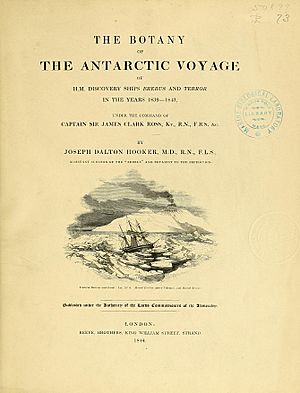Flora of Lord Auckland and Campbell's Islands facts for kids

Title page with an etching of Victoria Barrier with Mount Erebus and Mount Terror
|
|
| Author | Joseph Dalton Hooker |
|---|---|
| Illustrator | Walter Hood Fitch |
| Country | England |
| Language | English |
| Series | Monthly parts |
| Subject | Botany |
| Publisher | Reeve Brothers |
|
Publication date
|
1843–1845 |
The Flora of Lord Auckland and Campbell's Islands is a special book about plants. It describes plants found on two islands far away: Lord Auckland Island and Campbell Island. A famous plant scientist named Joseph Dalton Hooker wrote it. The book was published in London between 1843 and 1845.
Hooker was an assistant surgeon on a big journey called the Ross expedition. He collected many plants during this trip. This book was the first of four "Flora" books. These books are like encyclopedias of plants from the southern parts of the world. The beautiful pictures in the book were drawn by Walter Hood Fitch. Most of the plants Hooker collected are now kept at the Kew Herbarium. This is a huge collection of dried plants.
Contents
Exploring Southern Plants
In 1839, the British government sent out a big trip. It was called the Ross expedition. The leader was James Clark Ross. The goal was to study magnetism and ocean geography in the far southern areas. Two ships, HMS Terror and HMS Erebus, sailed from Chatham on September 29, 1839.
Journey to the Islands
The ships made several stops along the way. They arrived at the Cape of Good Hope on April 4, 1840. Later, they found huge kelp plants near Marion Island. But strong winds stopped them from landing there. They also could not land on the Crozet Islands.
On May 12, the ships anchored at Christmas Harbour for over two months. Here, they collected all the plant types that James Cook had found before on the Kerguelen Islands. On August 16, they reached the River Derwent in Tasmania. They stayed there until November 12. A week later, the ships stopped at Lord Auckland's Islands and Campbell's Island. They explored these islands during the spring months.
Discoveries in the Ice
Further south, they found large floating "forests" of kelp. These were made of Macrocystis and Durvillaea plants. The ships then met icebergs at 61° S latitude. They saw thick pack-ice at 68° S latitude. During this part of the journey, they discovered Victoria Land, Mount Erebus, and Mount Terror.
After returning to Tasmania for three months, the ships went to New Zealand. They stayed there for three months to collect more plants. They visited other islands too. Finally, the ships returned to the Cape of Good Hope on April 4, 1843. By the end of the trip, they had collected and saved about 1,500 different types of plants!
What Plants Were Found?
Hooker noticed that the plants on the islands south of Tasmania and New Zealand were similar to those in New Zealand. They were very different from plants found in Australia.
Plants of Auckland and Campbell Islands
On the Auckland Islands, trees grow close to the sea. These include the Metrosideros umbellata tree. Other woody plants like Dracophyllum, Coprosma, Hebe, and Panax also grow there. Many ferns grow beneath these plants. Higher up, you can find alpine plants.
On the Campbell Islands, small bushes only grow in narrow, sheltered bays. These islands are steeper and rockier. They have less plant life, mostly grasses.
Types of Plants Collected
Hooker collected many different kinds of plants. These included:
- Seedplants: These are plants that produce seeds, like flowers and trees. The book lists many different kinds, including Myosotis capitata and Ranunculus pinguis.
- Ferns and Clubmosses: These are older types of plants that reproduce using spores instead of seeds. Examples include Lycopodium clavatum.
- Mosses: These are small, soft plants that often grow in damp places. Many different moss species were found, like Ptychomnion aciculare.
- Liverworts: These are tiny, simple plants, similar to mosses. Hooker found a very large number of liverworts. Most of them were first called Jungermannia, but their names have since changed. Examples include Jungermannia atrovirens and Riccardia multifida.
- Algae: These are plant-like organisms that live in water. Both green algae like Codium tomentosum and red algae like Ballia callitricha were found. Brown algae, such as the giant kelp Macrocystis pyrifera, were also described.
- Diatoms: These are tiny, single-celled algae with unique glass-like cell walls. One species, Schizonema crispum, was noted.
- Lichens: These are fascinating organisms made of a fungus and an alga living together. Many different lichens were found, including Pseudocyphellaria glabra.
- Fungi: These are organisms like mushrooms and molds. Hooker also described several fungi found on the islands.
The book lists the scientific names of all these plants. Sometimes, the names have changed over time as scientists learn more. The lists show how many different types of plants were found on these distant islands.
Images for kids
-
Ranunculus pinguis (Plate I)
-
Lycopodium clavatum is a cosmopolitan species
-
The lichen "Sticta freycinetii" (Pseudocyphellaria glabra)









